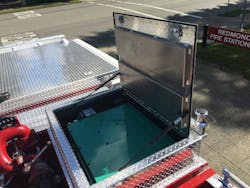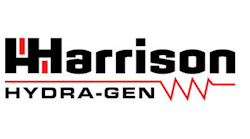Apparatus Idle-Reduction Technology Saves Lives and Money
Almost by accident, Redmond, WA, Fire Department found that when it comes to poisonous gases in firefighters’ blood streams, being outside near the apparatus is worse than going inside with an SCBA.
Redmond officials found that the carbon monoxide emitted from idling apparatus was a huge contributor to that elevated CO levels found in engineers and incident commanders.
“We were becoming more concerned about general CO levels in firefighters,” said Redmond Battalion Chief Mike Hilley, who is the department’s medical services administrator. “We started measuring everyone and found that firefighters going inside, with air packs, had zero, to one to two percent levels of CO,” Hilley said. “Then, we tested engineers and battalion chiefs and found they had five, six, seven percent CO levels.”
That was a startling discovery, Hilley said, noting that when levels are 15 percent or higher, patients are hospitalized for hyperbaric treatments.
“We found our larger CO exposures were from standing around the apparatus,” said Hilley, who is also Northeast King County’s medic and Redmond’s public information officer and safety officer. “Even if the engine is not actually pumping, and they are two, three or four deep, that’s a lot of CO.” With idle-reduction technology, only the apparatus that is doing the pumping or the aerial operations needs to have chassis engines running, all the other apparatus in staging or working other assignments are shut down, he said.
Going green
Hilley said Redmond is a green community and is striving very hard to be environmentally and health conscious. So based on the findings, it made sense for the department to find a way to reduce or eliminate as much of those noxious emissions as possible.
Redmond had already started being green and eco-friendly by purchasing alternative fuel, hybrid and all electric vehicles for use throughout the city’s fleet as a way to reduce emissions and save fossil fuels. So it made sense when Redmond started thinking about purchasing new fire apparatus that it looked at systems to reduce idling and the associated emissions.
Hilley said Redmond worked with Pierce Mfg. to come up with apparatus that was equipped with idle-reduction technology. He added Redmond is an all Pierce department, which has help standardize the fleet, not only for training purposes, but with maintenance. The department recently purchased three Pierce engines and a Pierce aerial with idle-reduction features.
The system Redmond uses includes a small generator and a system of batteries that keep vital apparatus systems functioning without having the big, diesel engines running.
“When you pull up and put it in park, a small generator kicks on after a certain period of time and shuts down the big engine,” Hilley explained. “That way you can still have all the lights on, the compartment lights, and still plug in things without all the engines running. That way, we reduce idling, reduce the hours on the engine and reduce all the emissions.
Hilley said one of the things that really pushed Redmond into installing the equipment on new apparatus is the discovery of an exhaust leak on a brand new SUV command vehicle. The operator had vague symptoms of headaches and other odd feelings, he said. The source was found by accident after a CO meter was put on him and the source of the poisoning was discovered.
Redmond didn’t purchase the new idle-reduction systems with that solely in mind, but it was a large factor—the health and safety of the personnel. He said every medic unit in the city has CO monitors and checking CO levels in firefighters has become routine during rehab.
“We are hoping to see a real reduction in CO levels,” Hilley said. “We’re really tickled with it.”
Last year, Redmond had a total of 10,955 responses with a breakdown of 4,916 aid calls, 3,825 paramedic calls and 2,214 suppression calls, Hilley reported.
Hilley said with three-person stations, the apparatus get used a lot and end up idling at scenes producing a lot of emissions that the environment and the firefighters can do without.
“Where we really noticed it was nursing homes and stores,” Hilley said. He added crews would pull up for assisting an ambulance, or checking an alarm and suddenly finding the lobby areas filled with fumes from the trucks. Additionally, the scenes are a lot quieter with fewer big apparatus running.
“Even on a car wreck, we’d be working the scene with the rig idling right next to where we’re working throwing CO everywhere,” he said. “Now we can have a nice quiet scene and we can hear what we’re doing.”
Hilley said Redmond’s Fire Apparatus Program Supervisor Doug Jones did a lot of research to come up with the system best suited for the city’s application and it’s worked well.
Some of Redmond’s older apparatus currently have systems to idle up the engines to make sure the electrical systems are not compromised. That just makes conditions worse with engines sitting at high idle.
Redmond’s venture into idle-reduction technology has piqued interest from neighboring fire departments who are looking at the benefits and seeking advice.
“We have the unions and the fire chief’s associations getting behind this as we are all concerned about preventing cancer,” Hilley said.
Hilley said he couldn’t imagine the city buying additional apparatus without idle-reduction features.
“It’s a matter of safety,” he said, adding that it wouldn’t be appropriate to have some firefighters have the benefit and others do without it.”
Other systems
Many of the major apparatus manufacturers offer some form of idle reduction or auxiliary power units as an option.
Rosenbauer America was one of the first to the market with its Green Star IRT system in 2009. The feature has been installed on literally hundreds of apparatus across the U.S. and Canada.
The company has three systems, one that uses a 7.9kW generator that produces AC current to run everything on the apparatus and provide 120 and 240 volts for scene operations.
Rosenbauer also has two battery systems, one that replaces chassis batteries with Lithium batteries to provide up to eight hours of scene operations without the engine running. It requires LED scene and warning lights, as well as a 120-volt AC inverter and a diesel-fired cab heater. The second battery system uses deep cycle batteries and works much like the lithium system, but with a three-hour run time.
E-ONE also offers auxiliary power units for apparatus. Winnipeg Fire Paramedic Service in Manitoba, Canada, recently purchased an E-ONE 100-foot aerial platform with the technology incorporated into the apparatus.
“Our innovation committee is dedicated to making equipment smarter,” says Kevin Munoz, Fleet Commander for the City of Winnipeg.
Winnipeg serves a population of over 700,000 spread across 184 square miles. The city responds to an average of 64,000 incidents per year, so Munoz said efficiency is important.
The system on Winnipeg’s E-ONE platform is an IRT 10K160 diesel Auxiliary Power Unit, or APU, manufactured by Harrison Hydra-Gen. It is designed to reduce fuel use as well as engine wear by taking over the core power functions when the chassis engine shuts down. It starts automatically when the truck is stationary, providing power for such functions as heating and light.
“This integral component of the E-ONE platform has proven to save fuel,” Munoz said. “Just as importantly it, it reduces maintenance costs for our department, saving the city money.”










